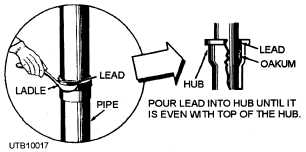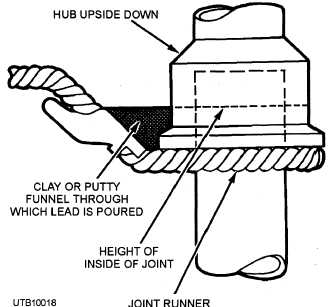
Figure 3-18. - Pouring hot lead into a joint.
Perform caulking operations using an inside caulking iron first and then an outside caulking iron (views 4 and 3, fig. 3-17). Drive the lead down upon the oakum and into contact with the spigot surface on one edge and against the inner surface of the hub on the other. Strike the caulking iron gently but firmly with a hammer. Caulking the lead too tightly can crack the pipe. A cracked pipe or fitting must be replaced. A pickout iron (view 5, fig. 3-17) should be used when oakum and lead must be removed from a joint.
Sometimes a joint must be made in a vertical line with the hub upside down as in a vent stack. Prepare the ends of the pipes and pack the joint with oakum, as shown in view B, figure 3-16. Clamp a joint runner around the pipe. Raise the end of the joint runner, as shown in figure 3-19, and make a funnel in the raised end, using fine clay, putty, or plaster. The funnel must be at least as high as the inside height of the lead portion of the joint.
CAUTION
Be sure the funnel is dry before the lead is poured to prevent the hot lead from blowing out. Pour the lead and allow it to cool before removing the joint runner. Caulk the lead with a caulking iron to adjust it to the inside walls of the hubs.
When making a horizontal caulked joint, you must prepare the ends of the pipes by packing the joint with oakum, as shown in view A, figure 3-20. Clamp a joint runner around the pipe; place a small piece of oakum between the clamp and the pipe to seal the gap and prevent hot lead from running out of the joint; and then fill the joint with melted lead, as shown in view B, figure 3-20. After the lead hardens, remove the runner and the trim off of the surplus lead with a chisel. Caulk the lead in the same way as a vertical joint, as shown in view C, figure 3-20.

Figure 3-19. - Making an upside-down joint.
When making a lead-wool joint in cast-iron soil pipe, you need a yarning iron and a caulking iron. This is a cold-caulked joint and should be used where a line is underwater or in a wet place where molten lead cannot be used. Before starting the joint, place the spigot end of the pipe to be installed in the hub of the soil pipe. Make sure the pipe is blocked securely with braces to prevent shifting. The pipe must also be centered in the hub, so the thickness of the joint is uniform. With the pipe braced firmly and in proper position for joining, make the joint following the procedure provided below:
Pack oakum in the joint to within 1 inch of the top of the hub. Use a ball peen hammer and a packing iron to tamp the oakum tightly in the joint.
Pack two 1/2-inch layers of lead wool over the oakum.
Tamp the lead wool tightly into the joint, using the caulking irons and the ball peen hammer. (See fig. 3-21.)
In making a compression joint, you should be sure to clean the internal surface of the hub and the external surface of the pipe and/or fitting to be joined. When using a cut pipe, you can remove the sharp edge by peening or by lightly filing the rough edge to permit the pipe to slide and NOT gouge into the gasket. Insert the gasket into the hub, and make sure the retaining flange or collar of the gasket is next to the face of the hub. Be sure to use the recommended lubricants available (normally a soap or an adhesive type). They are applied to the inside of the gasket. Align the spigot 3-13
Continue Reading